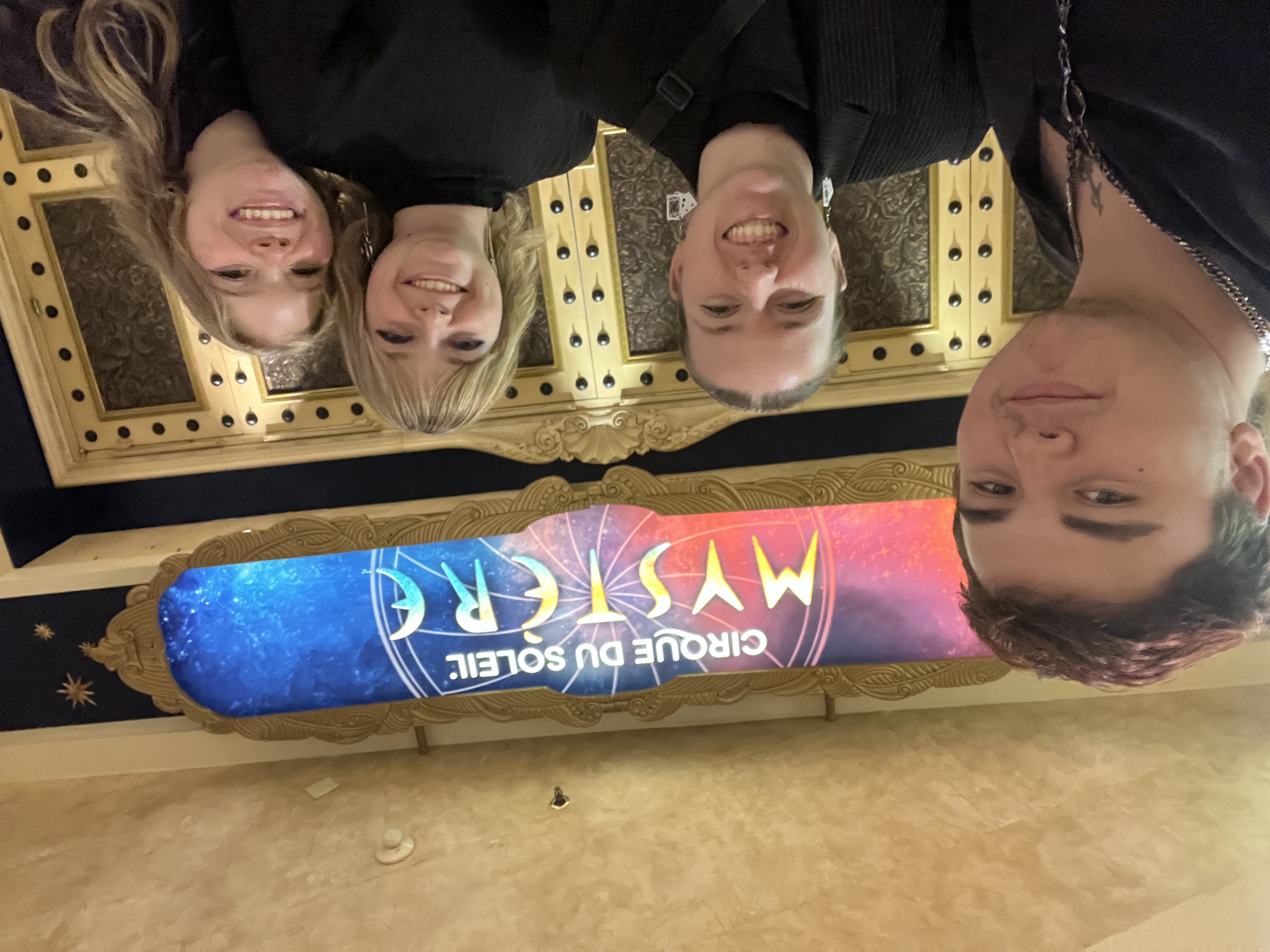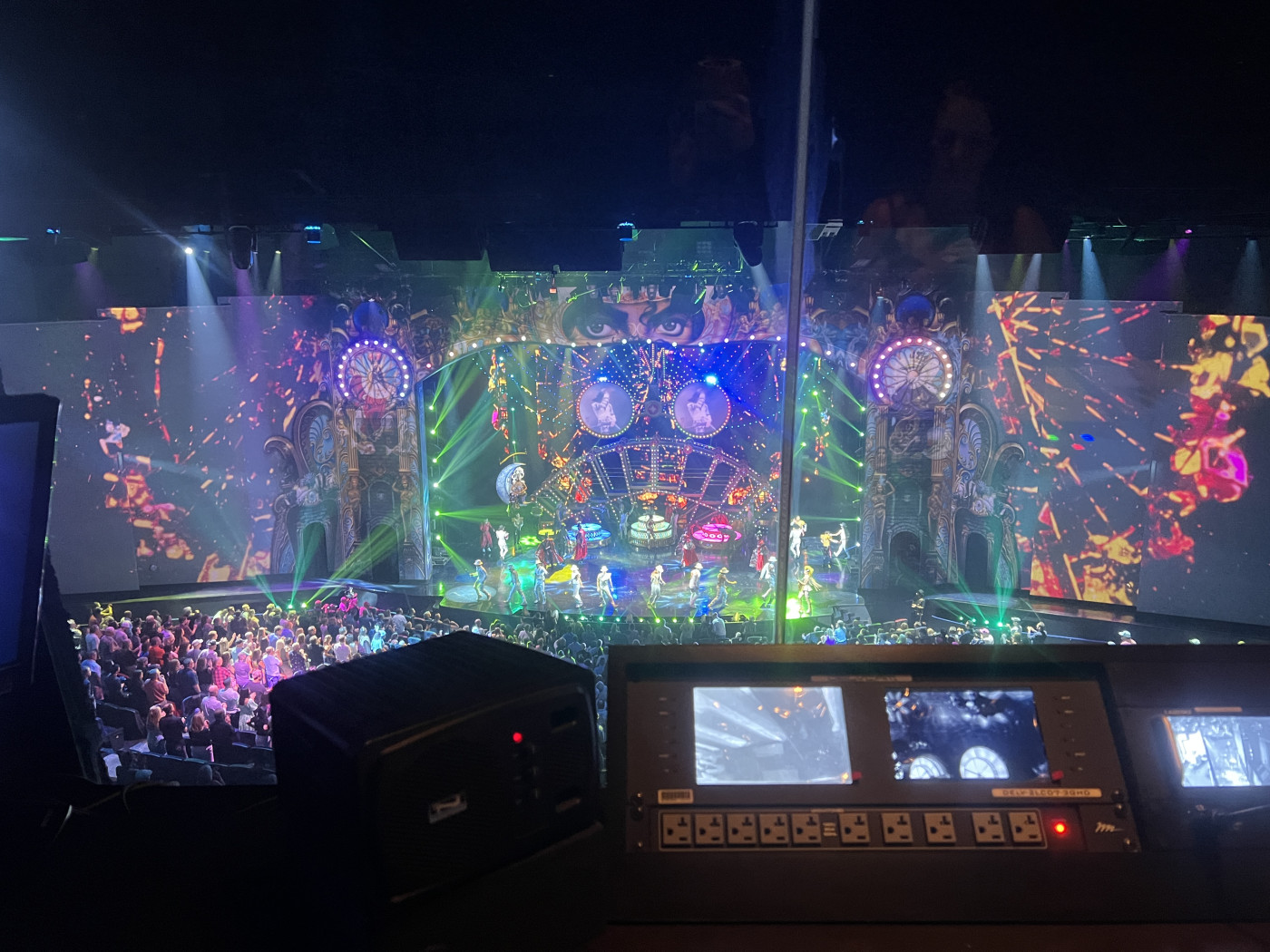Written and photographed by Sierra Loertscher (Theatre, Stage Management ‘25)
Four members of the Stage Management Program had the opportunity over Fall Break to visit Vegas and shadow stage managers from Blue Man Group and five different Cirque du Soleil shows. This trip is planned every year for the juniors and seniors in the Stage Management Program. It gives them an opportunity to meet with professionals, call a show, and learn new techniques and skills to incorporate. Each member gets to shadow three shows over three days. This trip was made possible through Mandi Harms at Mad Apple and Emily Beatse (an alumna!) at O.
 Stage Manager students at Mystere. Left to right: Skyler LeMelle, Sierra Loertscher, Bella Dixon, Julia Witesman
Stage Manager students at Mystere. Left to right: Skyler LeMelle, Sierra Loertscher, Bella Dixon, Julia Witesman
The first Cirque show we visited was Mystère, which is a very classic circus: think acrobats and balancing acts. We were given a tour of the space, as well as some advice from the stage manager Julie Maury. You see, Cirque du Soleil has an SM Internship program that is well known and practically guarantees your place in the industry. Many of our SMs apply for the internship every year, and both of our contacts in Cirque got the internship. Maury’s advice was very helpful: she recommended diversifying the type of shows you work on and also suggested that writing a good cover letter is sometimes more important than your resume. If you can explain why you are the best choice for a company right now, it stands out more than your 4 college credits and a summer show. She emphasized: “Why you, why now, why Cirque?.” Maury, herself, comes from the internship, and she’s worked for Cirque for almost 10 years.
One show we all got to shadow was Mad Apple in NYNY. For a Cirque show, it is pretty small, but they keep it entertaining with the variety of acts. I was able to follow the backstage track with two of the Assistant Stage Managers (ASMs). The team is very close-knit, since most of them worked together on the recently closed ‘Love’ at the Mirage. I noticed the team was committed to safety—that’s what the ASMs watched for while the SM called the main act. One thing that makes Mad Apple unique is the backstage crew. Because of the theming of the show, they prefer the crew to be visible, so a few times we went out into the audience, and even stood onstage while an act was going on! This show was our favorite.
The biggest show we shadowed was KÀ. This show is unique in two ways to Cirque: it was the first to follow a narrative storyline, and its main stage can fully rotate and tilt because of a massive gantry crane. I had the privilege of being backstage during the show, and I got to watch as the crew—supported on harnesses—loaded the actors onto the various stages. This show is a technician’s dream! Every piece of the process is a well-oiled machine, since any one mistake means danger to the cast and crew. We were able to watch the SMs make the Lineup, which essentially is a cast list for each show, taking into account training hours, sick leave, and understudy roles. The three ASMs backstage have very big tracks, so following them around got me to 10,000 steps! I would love to shadow KÀ again.
 A view of KÀ from inside of the booth
A view of KÀ from inside of the booth
My final shadow of the trip was MJOne. I was able to watch the SM Cassie Apthorpe call the show from the booth. All of the cues are able to be set to time code, since every second of the show has music. Apthorpe has the call down to a rhythm, so we focused on watching the three lifts to make sure they were loaded properly before being raised up to stage level. Since I had a copy of the calling script I could follow along with, I noticed many places where if a technical element failed, a list of steps was given so the show could continue with the right cues being called. After it finished, she showed me their contingency binder and explained how in the event that a planned technical element is missing or dysfunctional, an audio is played only to the cast onstage, and they know to keep track of their surroundings and figure out what is wrong. Our group mentioned one thing that was especially beneficial on this trip was seeing how the team handled it when things went wrong. We all know how to call a show correctly, but it’s important to think on your feet and have a great understanding of the show when things go wrong.
Our seminar and other classes (like “Advanced SM: Types and Styles”) prepared us to come in with questions and focus on each call. All four of us found this trip rewarding, and we are glad to be part of a program that has these opportunities for young people to immerse themselves in a professional environment and learn from the best.

